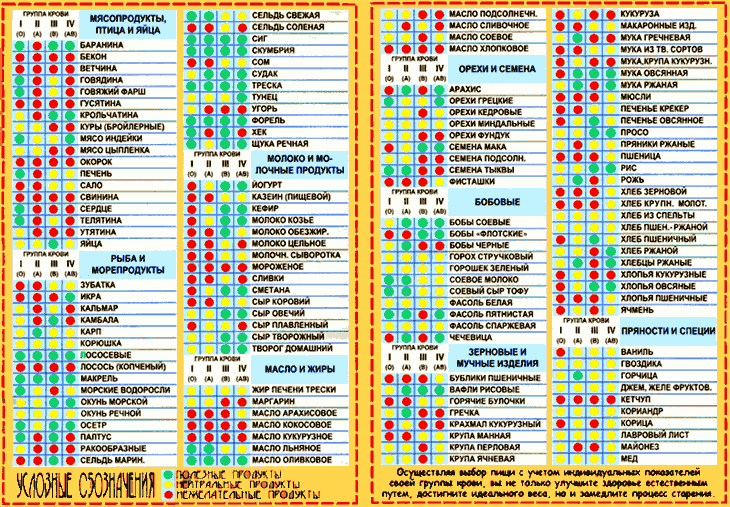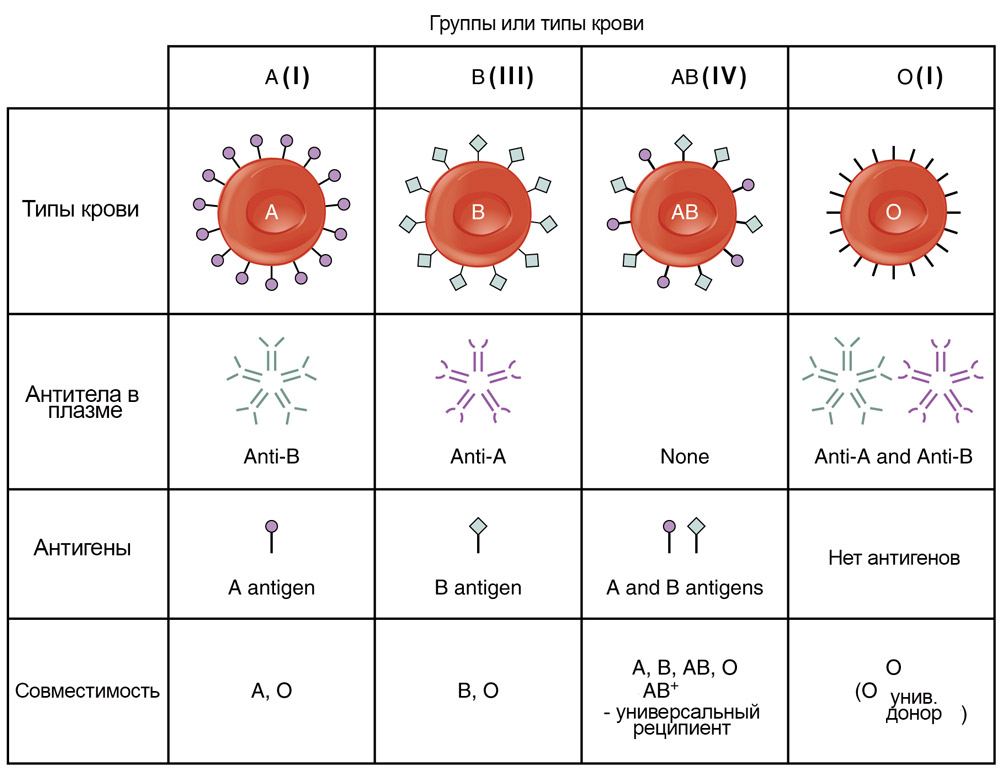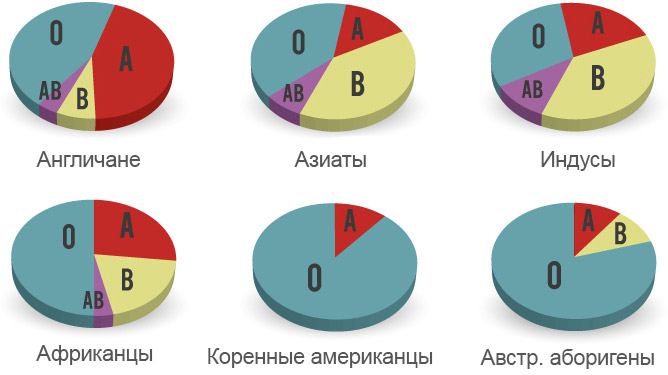Diet according to blood types from a scientific point of view
Let’s look at the so-called blood type diets - do they have proven effectiveness? What is the basis for the statement about the need for products for each blood type? The topic is incredibly popular, with a huge number of positive reviews. What if it actually works? Analysis of the main theses of the diet from a scientific point of view.
Who developed the blood type diet?
Despite the fact that the scientific community has reached a consensus that blood type does not affect the choice of nutrition, it is precisely the opposite statement naturopath (naturopathy is an alternative medicine, the adherents of which do not believe in the scientific explanation of processes in living organisms. According to them opinion, life is controlled by a supernatural force. In the areas of naturopathy there are a lot of pseudoscientific and frankly charlatan movements) Peter D’Adamo developed a diet according to blood groups (he does not have a higher medical education, he has “healer” license). According to D’Adamo, the physiological characteristics of a particular organism correlate with blood type, and each blood type has a different evolutionary heritage, therefore, nutrition also depends on blood type. His conclusions are based on medical practice and observations of patients. The doctor did not conduct controlled studies, but this is not necessary - the naturopath conducts seminars all over the world and sells books in millions of copies and without any evidence base.
What is the blood type diet based on?
The prerequisite for creating the diet is the erroneous idea that human blood groups began to appear 60 thousand years ago among primitive hunters.
Greater apes (anthropoids, hominoids) have the same 4 blood groups, and they cannot be classified as “hunters”, or “farmers”, or “nomads”.
D’Adamo’s theory of the evolution of blood types, based on personal opinion about social evolution, in several theses:
- The first universal blood type 0(I) was formed thanks to the diet of Neanderthal hunter-gatherers 60,000 years ago (by the way, you and I are not direct descendants of Neanderthals, no matter what blood type we have). Before Neanderthals there were no blood types. People with blood type 0(I) should adhere to a “paleo diet” - high in animal protein and greens. Cereals are contraindicated for them.
- The second blood group A(II) appeared around 15,000 BC. when young humanity switched from hunting and gathering to an agricultural way of life. For the “agrarian” blood type, it is not recommended to consume food of animal origin, including dairy products. Modern people with A(II) should adhere to a vegetarian diet.
- The third blood group B(III) arose 10,000 thousand BC, when some groups of people began to nomad and eat cereals, the races began to mix (!). A balanced diet is recommended, but seafood, pork and chicken should be avoided.
- The fourth blood group AB(IV) originated from a mixture of the second and third, thanks to diversity in diet, about 1500 years ago, literally yesterday by evolutionary standards. Nutrition recommendations in this group are quite contradictory (as in other types).
Where Peter D’Adamo got these facts from, I don’t know. There are no such hypotheses in textbooks on anthropology and hematology, let alone theories or facts. The evolutionary biological basis of the blood type diet is based on the incompetence of its author. Moreover, an American Society of Nutrition meta-analysis of 1,415 articles related to blood type nutrition found only one article that met the selection criteria on the topic (this was the only study on the relationship between cholesterol and blood type; read more in original source ).
How the evolution of blood groups actually happened
Phylogenetic tree evolution of AB0 genes
Immunogeneticists Luis C. de Mattos and Haroldo Moreira talk about the origin of blood groups in the Brazilian Journal of Hematology: “The 0(I) blood group was not the first in an evolutionary sense. This would mean that the 0 gene evolved before the A and B genes, in [ tooltip tip=“Locus is a fixed position of a gene on a chromosome.”]locus[/tooltip] AB0, but this is not so. Phylogenetic relationships between human and non-human forms of AB0 genes ([tooltip tip=“Allele - different forms of the same gene, located at the same loci and responsible for the same trait.”]alleles[/tooltip]) show that type A (II) developed first. Type 0 (I) is abnormal in relation to A and B.” For more information about the origin of blood groups and their evolutionary development, read the original article entitled [“Was the O type the first blood type to appear in humans?”]( https://www.scielo.br/scielo.php?script =sci_arttext&pid=S1516-84842004000100012&lng=en&nrm=iso&tlng=en).
Detailed review of the book by P. D’Adamo “Four blood groups - four paths to health” from a senior researcher at the Laboratory of Anthropoecology of the Research Institute and Museum of Anthropology of Moscow State University, Doctor of Biological Sciences, Candidate of Medical Sciences. Andrei Igorevich Kozlov on the website Anthropogenez.ru , I recommend that you familiarize yourself with it, and the site is generally magnificent - the fruit of many years of work by the best Russian popularizers of science. Anthropogenesis has most of the answers on the topic of blood evolution.
Humanity already had all blood types long before the advent of agriculture.
The second group evolved from the common ancestor of chimpanzees and hominids about 5-6 million years ago. The first group appeared about 3.5 million years ago. B(III) evolved from A(II) about 2.5 million years ago. According to Dr. D’Adamo’s logic, the second blood type should be “predominantly meat-eating.”
The next mistake of the author of the diet is that agriculture developed locally, and it was in that “agricultural Eden” that blood type A(II) arose, and its carriers must now adhere to vegetarianism. However, anthropological findings and genetic studies indicate that agriculture developed completely independently in different parts of the world. Sowing practices among the first sedentary communities did not develop for centuries, and rarely ended in success. The optimistic statements of the author of the diet that the first farmers were healthier than hunter-gatherers are far from reality: since the beginning of agriculture in the Middle East, people have lost about 15 cm in height. Considering that agriculture was 100% organic. In addition, genetic adaptation is not able to keep pace with cultural and technological progress.
What is blood type/group and what depends on it
I suggest watching a five-minute video that talks about blood groups and Rh factors in simple language. This video contains the entire theoretical minimum, presented concisely and without unnecessary details.
What’s wrong with lectins?
The foundation of the blood type diet theory is based on lectins. Lectins are proteins and enzymes that can clump red blood cells (erythrocytes). The author of the diet claims that lectins contained in food that is inappropriate for our blood group lead to systematic serious health problems: “clumping” of red blood cells, cirrhosis of the liver, heart attacks, blockage of blood vessels, kidney failure, atherosclerosis, decreased immunity, etc.
It is argued that with the wrong selection of products, every person is daily exposed to the destructive action of lectins - the vessels of vital organs will begin to become clogged with glued red blood cells. Lectin-induced functional impairment syndrome should be widespread and medically studied. First of all, pathologists should know about it, since the damage during the described processes should be extensive, especially in older people. This disease, caused by lectin reserves and agglutinated blood cells, cannot be hidden and must have a clear description, complete with photographs from optical and electron microscopes, cytology, sections, and cell histology.
However, science knows nothing about red blood cells glued together with lectins… Moreover, lectins are widespread in nature - they are found in both plants and animals, and not just in wheat, soy and corn. Most lectins, of which there are about 800 types, are not enzymes at all and only a few are involved in the immune response. Lectins play their role in living organisms - they activate lymphocytes (immune response cells) and stimulate their division, and participate in the germination of plant seeds.
If you systematically eat large amounts of soybeans and make them the basis of your diet, you can develop intestinal upset due to the toxic soy lectin agglutinin. But cooking negates the toxicity of agglutinin - boiling for 10 minutes neutralizes up to 99% of lectins in the product. Soaking flushes out some of the lectins, and the fermentation process “digests” them - wheat yeast buns become more than safe for your intestines. Yes, eating raw beans can really kill you, as can a tablespoon of salt or 3 liters of water - this ironic list is endless.
The effect of lectins does not depend on your blood type!
Gluten intolerance does not depend on blood type, but what will happen to such a person if, following a diet appropriate for his blood type, he still forces himself to eat grains? By the way, this is a rather rare genetic disease, but it is now very fashionable to consider gluten harmful for literally everyone. This is wrong.
In general, there are about 300 blood types - according to Rh factors and their combination with group and other classifications. What diet will a naturopath prescribe for us in each case?
What does blood type depend on?
Bacteria and viruses are responsible for the diversity of blood groups, to which evolutionary protection has been built over millions of years. Indeed, there is a correlation between certain populations and blood types. This diversity is due to natural selection pressure through viral and bacterial infections, but not due to nutrition. The proof of this theory is provided by special mathematical models developed at University College in London by Professor Robert Seymour and his colleagues (at link full text of the study with a mathematical model and formulas). Their model shows that if viral infections predominate in a population, then blood type 0(I) predominates; if bacterial infections are more common, then types A and B will be more common. Dietary differences have nothing to do with this.
Blood type and race
Peter D’Adamo’s hints that the first blood group belongs to a superior race smacks of you know what. Race cannot be determined from a blood test. [tooltip tip=“Race - Classification of people into groups based on physical characteristics, culture, genetics. The classification of races is constantly changing. The word race is now increasingly being replaced by ethnic group. Scientists do not have a consensus on whether race correlates with biological characteristics. All races belong to one species, Homo sapiens, and a subspecies, Homo sapiens sapiens.”]Races[/tooltip] are not separate species of people! Research into human biology does not support any cause-and-effect relationship between race and blood type, although correlations are present. Humanity is unusually homogeneous in its “composition” and origin.
We are 99.9% genetically identical, regardless of race, even taking into account gender, external and individual personality traits. Such “homogeneity” is not so common in nature - chimpanzees have 2-3 times more genetic variations, orangutans - 8-10 times (also our close relatives). There are certain factors that initially influenced the prevalence of blood groups in some closed populations - a small number of ancestors (as in Australia); the “bottleneck” effect, which is not uncommon for aboriginal peoples; intra-group marriages, etc.
One example. Lactose intolerance is associated solely with the lactose tolerance gene. Among US Indians, 100% lactose intolerance is 30-35% II(A), while Thais with 98% intolerance have 25-30% III(B) alleles. The 100% meat-eating Eskimos have a lactose intolerance of 80% - 80-90% I(0) ( source ).
Blood type and diseases. Is there a connection?
The connection between immunity and blood type is discussed above. Some diseases actually have a connection with blood type. This relationship has been unconditionally proven in only seven diseases (!). Where then does the data on the relationship of a particular disease with blood type come from? Dr. Eric Topol notes: “Often, the practice of looking for correlations in large volumes of data leads to any result - you need to link the risk of cardiovascular disease and the second blood type? Take a sample of tens of thousands of people and you will find any connection.” Read more about the connection between blood type and diseases here .
Why do carriers of I(0) suffer from stomach ulcers more often? In 1993, the bacterium Helicobacter pylori was discovered, which has a special affinity with one of the unique proteins of this group. This is just one example among hundreds of others.
Instead of worrying about your blood type, we need to focus on the real causes of our most common diseases - sedentary lifestyle, smoking, overeating. These are real, undeniable risk factors that affect our health, regardless of blood type.
Does the blood type diet work?
The first fundamental study of Dr. D’Adamo’s diet was conducted in 2014 and the full text of the study was published in the peer-reviewed journal Plos.One. Title of the article “AB0 genotype, blood type diet and cardiometabolic risk factors” . This is a really high quality, cited study done at the University of Toronto. In principle, it is enough to understand only this study - it provides answers to all the questions that I raised in my article, including a lot of links for further study of the topic.
Since the goal of blood type nutrition is to reduce the risk of “specialty” diseases, especially those related to blood vessels (remember lectins?), this study aimed to determine the relationship between diet and cardiometabolic health. I strongly recommend that you read the details of the study at the link above, especially if you have doubts, but I will write its conclusions here: adherence to any blood type diet has a beneficial effect on cardiometabolic risks, but it does not matter which of the proposed diets the carrier prefers one of the blood types.
That is, all recommendations, regimens and product lists lead to good results in healthy people who do not need a special diet for medical reasons, regardless of blood type. No significant associations were found. Each of the diets led to the expected result: a decrease in body weight, waist size, a decrease in blood pressure, serum cholesterol, and insulin. Strict adherence to the AB(IV) diet reduced the levels of these antigens, but did not affect weight loss. Strict adherence to the I(0) diet reduced triglycerides (fats). The effect of the diet was not increased when administered by the appropriate carrier type.
Tips from the blood type diet are mostly harmless and can be useful on an individual basis. An exception may be the recommendation to introduce dairy products to representatives of group III (B) with lactose intolerance and other special cases - urolithiasis and a meat diet, gout and purine-rich foods, etc.
Nutrition based on blood types has no scientific basis.
I do not want to develop the theme described in D’Adamo’s book about the connection between blood type and character. To understand how unfounded claims about such a connection are, it is enough to mention the [“Barnum Effect”]( https://ru.wikipedia.org/wiki/%D0%AD%D1%84%D1%84%D0%B5%D0% BA%D1%82_%D0%91%D0%B0%D1%80%D0%BD%D1%83%D0%BC%D0%B0).
Video that inspired this review:
The original article on which the video is based is published on the website skepdic.com . At the end, Boris conducts a test on the “Barnum Effect”, if you are not familiar with this, then you should be interested.
If you don’t believe in the theory of evolution, then eating according to blood types should make even less sense to you, as should any paleo diet based on the biological development of the species Homo.
Update 10.22.20 A wonderful popular science article on Postnauka, dedicated to blood groups, will be of interest to anyone interested in this issue.








